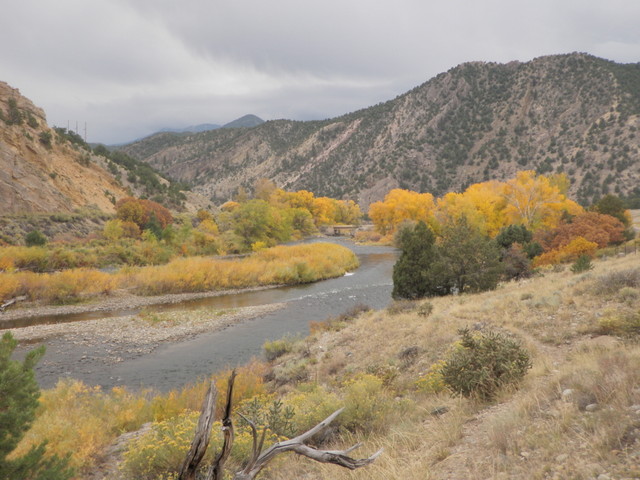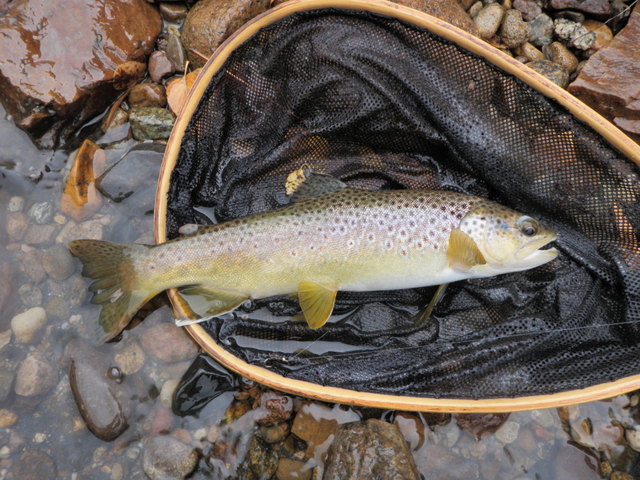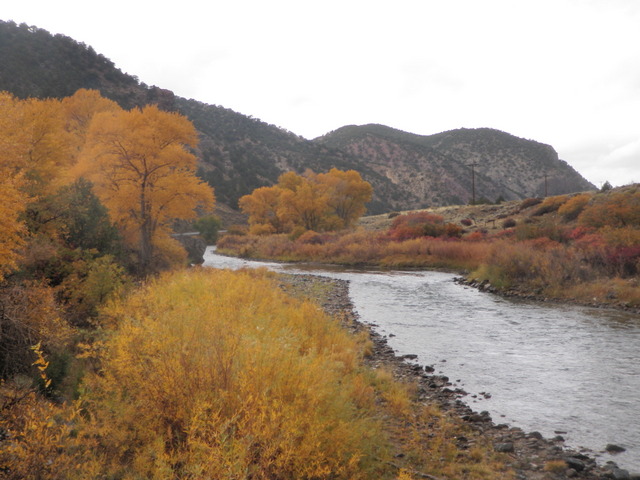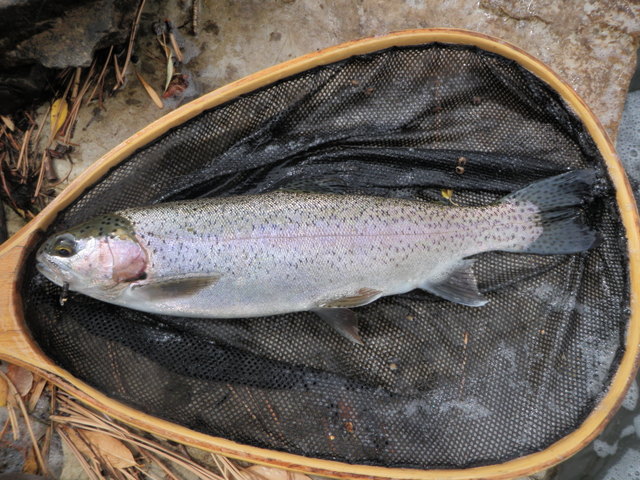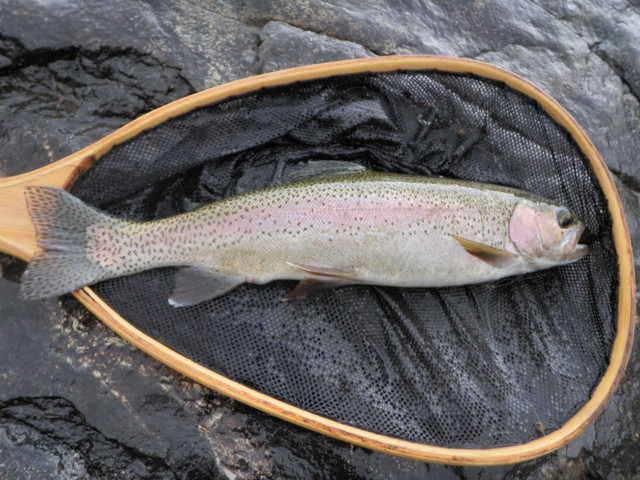Time: 11:00AM – 4:00PM
Location: Lunch Rock Above Wellsville Bridge
Fish landed: 15
Arkansas River 10/12/2012 Photo Album
Clearly the season was waning and I was anxious to make a few more productive fishing trips before settling into fly tying mode. The Arkansas River reports indicated strong BWO hatches on overcast days and Friday’s weather was shaping up to be ideal BWO conditions so I made the nearly three hour trip. I decided to move downstream from my previous two visits for variety and to try new water.
I parked at lunch rock, a massive rock that juts into the river and creates a huge eddy just beyond the large bend in the highway above the Wellsville bridge. This spot was a favorite of mine when I first moved to Colorado and began tossing flies on the Arkansas River, but in recent years I gravitated to the juicy water a bit further upstream. The car temperature registered in the mid-40’s as I dressed for fishing so I pulled on four layers including my raincoat and ski hat in preparation for a day on the river. My weather app on the iPhone forecast high temperatures of 59 with a high chance of afternoon showers and thunderstorms.
I planned to start with the new nymphing rig introduced to Dave Gaboury and me on our guided fishing trip and then switch to the familiar tapered leader setup if a decent BWO hatch developed so I chose my Sage 9 ft., 4 weight rod because it is long and stiff and works well for casting nymph rigs. I assembled the four piece rod, but decided to wait until I was by the river to convert from the tapered leader to the nymph rig. As I walked downstream along the shoulder of the highway toward the Wellsville bridge I noticed some dark gray clouds gathering in the southeastern sky, but didn’t get too concerned as rain wasn’t supposed to arrive until noon, and I was on track to be on the water by 10AM.
I found a place where the top wire of the barbed wire fence had been removed and it was obvious fishermen accessed the river, so I carefully climbed over and then slowly maneuvered my way down the steep bank to the river. I reached the river where it split around a small island and the character was shallow riffles on both branches so I crossed the wide shallow flow and then climbed the steep bank on the eastern side and worked my way upstream to the head of a beautiful long deep pool. As I sat on a large rock and removed my tapered leader and coiled it on to a blank tippet spool that I kept in my front pack for this purpose, I heard the rumbling of distant thunder. I was about to pull out the 0X tippet spool I’d purchased to connect the end of the fly line to the thingamabobber, when I noticed several flashes of lightning followed briefly by thunder. This unnerved me, and I didn’t want to be caught this far from my car in the event of an intense thunderstorm, so I retraced my steps and made the long loop back along the bank, crossed the river carefully at the top of the island again, and then hiked back along the right shoulder of the road.
By the time I reached the car the lightening and thunder had subsided, but it was raining moderately hard, so I opened the hatch and finished rigging my line with the shelter of the car at my disposal. I cut a 9 inch section of heavy monofilament and tied a loop on the one end and then executed a loop to loop connection with the end of the fly line. I used a clinch knot to connect the thingamabobber to the end of the 9 inch section which was now reduced to 6 inches due to the knot tying on both ends. Next I uncoiled four feet of 3X and tied that through the same opening on the thingamabobber and then connected a section of 5X to the end of the 3X and crimped a split shot above the surgeon’s knot. It was now time to choose a fly. I wanted to use a 20 incher to duplicate Taylor’s setup, but I only had one that I purchased at RGA, and I wanted to keep that for a model for tying some myself, so I used a beadhead prince in a size 12. Next I used a clinch knot to tie another section of 5X through the eye of the prince and a foot or so below the top fly, I tied on a Craven soft hackle emerger with no bead.
I was ready to go and decided not to make the long loop again, so I descended to the river below lunch rock and then hiked a path down along the river. I ended up just above the spot where I initially intended to begin but on the side of the river bordering the road, and it was now 11AM when I finally began to cast. The first long deep run and pool didn’t produce any fish, but the next spot had a strong fast deep run within ten feet of the bank I was on. I began casting directly upstream to the water between the current seam and the bank and it wasn’t long before the indicator dipped and set the hook and played a nice chunky brown with the prince nymph in its lip. With all the rigging steps, I’d forgotten to crimp the barb on the prince and I had to work the fly at length with the fish in the water to finally remove the fly. In the process of applying pressure to the fly, the two white biot wings fell out and I now had a minimal beadhead nymph with tails and a peacock body.
I decided to stick with the handicapped fly and the fish didn’t seem to care about the lack of wings, and in fact the fly without wings looked more similar to a 20 incher. I moved to the top of the narrow corridor of productive water and added two quite nice browns that attacked the Craven soft hackle emerger on the lift, and I was quite pleased with the early action. As I progressed back up to lunch rock I landed a smaller brown on the maimed prince and another nice brown on the soft hackle reaching five fish landed and I arrived at the Santa Fe by noon. By now the rain had stopped but my hands were quite chilled from being wet and the cooling effect of evaporation, so I decided to return to the car to eat lunch even though I’d stashed it in my backpack for eating by the river.
I sat in the driver’s seat and ran the heater and turned on the heated seat while munching my lunch. The dashboard thermometer registered 57 degrees, but it certainly felt colder than that to me. After lunch I resumed my search for fish by beginning in a beautiful deep run above lunch rock, and here I hooked and landed a hot rainbow that forced me to negotiate my way down the steep path from the high rock while playing the fish. This fish also took the prince so I’d now landed an equal number on each fly. Since I was now on the bank directly across from the deep run, I made some casts across and let the nymphs drift down into the sweet spot at the base of the run, and had two momentary hookups.
I moved on and worked the pockets and runs along the left bank right next to the road and increased my fish count from six to ten before reaching the tail of a beautiful long smooth pool. From head to tail the pool was probably 30 or 40 yards, and I decided to cross at the shallow tail and work up the bank away from the highway. At this point the sky to the west had become quite dark and clearly more rain was imminent, but I didn’t hear thunder, so I decided to gamble and make the crossing. I was already prepared with my raincoat on and the hood was pulled up over my stocking hat.
I skipped the lower smooth section of the pool and moved to the midsection where there were a lot of large submerged boulders, and it looked like dynamite brown trout water. As I began casting my flies upstream and across and dead drifting them with a nice swing below me I noticed a nice rainbow eight feet in front of me in front of one of the large submerged boulders. As I watched, the rainbow was clearly feeding on something subsurface and actually rose and sipped something once or twice. I didn’t want to go through the hassle of switching my entire rig to the tapered leader to fish a dry, so I cast upstream and attempted to execute a swing in front of the fish. On perhaps my fifth attempt as I lifted my rod to swing the flies in front of the fish, it moved a foot to its right and chomped on the prince. The fight was on and the rainbow ripped line and made several streaks downstream and up before I could pressure it to the side and scoop it in my net.
By now the rain had begun and it was coming down harder than at any other point in the day. These were perfect BWO conditions, but other than my ability to catch quite a few fish on the size 22 Craven soft hackle emerger, there was no evidence that BWO’s existed on the Arkansas River. I managed to land a medium sized brown in the riffles at the head of the long pool and had two or three momentary hook ups in spite of using the down and across hook set taught by my guide, Taylor.
I waded further upstream along the bank prospecting with the nymphs and spotted a rise in front of an exposed rock. I attempted to execute the same swing technique, and sure enough five to eight feet above the rise, I felt some weight on the lift and set the hook. This action resulted in a fifteen plus inch brown leaping from the water which exposed the entire fish. Unfortunately it dove and somehow went under a stick and came free. Shortly thereafter I hooked another hot fish that streaked upstream and shook off the hook after a brief dash, but then I covered quite a bit of water with no additional action until I came to an interesting area with large high vertical rocks coming down to the water. As I gazed upstream and peered through the moderate rain I noticed another crazy fisherman waded waist deep into the run from the highway side of the river, and he was similarly hunched over in his rain jacket and hood.
I didn’t feel like climbing the rocks and circling around and above him, so I turned around and retreated with the intent of calling it a day; however, when I came next to the top of the head of the long pool, I decided to make some more casts to the area where I’d had several momentary hookups on the downstream swing. Sure enough on a long cast across to the current seam and on a downstream drift, the indicator paused and I set the hook with a down and across the chest sweep and hooked and landed a small brown. The rain was now waning a bit and small patches of blue were appearing in the western sky. As I began casting again, I observed several rises downstream and below me, and then two more fish created some rings, so I decided to make the conversion to dries.
I sat down on a rock in the continuing light rain and began the process of clipping off flies, tippet and thingamabobber, and unfortunately this process consumed around 15 minutes which probably represented 50% of the total elapsed surface fishing time. Finally I was ready and tied a size 22 CDC BWO to the end of my line and began to cast across and allow the fly to drift downstream to the fish rising in front of an exposed boulder. I was having great difficulty following my tiny tuft of a fly in the overcast dim light, but the fish continued to rise but not take my fly. Eventually I reeled up and replaced my fly with an even smaller size 24 CDC BWO. Because of the rain the CDC wings were already wet before I cast, so I had to spend time drying and fluffing.
As this was going on the sky was gradually getting brighter and I could see my tiny speck of a fly when the wing was fluffed out. After four or five casts with the size 24, I placed one just above the rock and a small brown rose and sipped it in. Meanwhile several move fish continued to rise downstream 10 yards or so in a current seam that flowed around another exposed boulder. I waded to the bank and moved down a bit so I was above the fish rising closest to me. After a few unsuccessful casts and downstream drifts, this fish also inhaled my offering, and this time I landed an eleven inch brown. Unfortunately after releasing this fish as I dried and fluffed the fly the sun came out and the fish discontinued their feeding. I decided to wade across at the tail and observe the area along the bank next to the road where I’d seen some rises while reconfiguring my line. I paused at the tail of the pool and looked upstream and observed for five minutes or so, but nothing was showing so I climbed the bank and returned to the car.
Shadows were now covering half the river and the temperature dived as the sun sank lower in the sky. My sleeves were wet from the rain trickling down my arms as I cast and as I worked on my rigging so I was feeling quite chilled and my hands were stiff and curled. I decided to abandon efforts to catch more fish at 4PM and made the three hour drive back to Denver in time to have dinner with Jane.
It was a nice day on the Arkansas as I deployed the new nymphing rig and landed quite a few chunky fish in the 12-15 inch range. The Craven soft hackle continued to perform and I rediscovered some new water. I managed to weather quite a bit of rain and remained relatively dry. I didn’t succeed in enjoying extended BWO surface fishing, but did manage to pick up a few fish on dries. Hopefully there will be a few more successful days of fishing in 2012 before the curtain closes.

